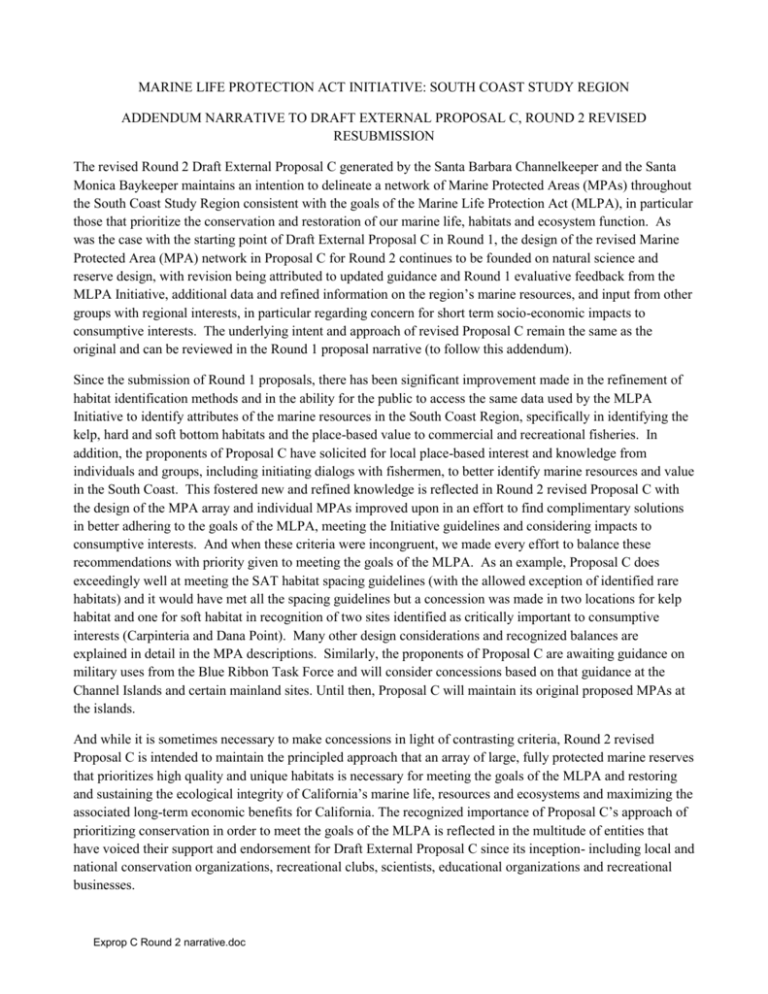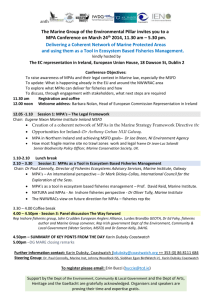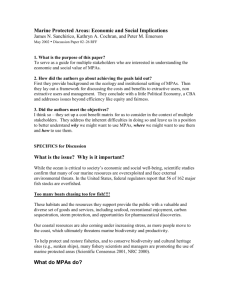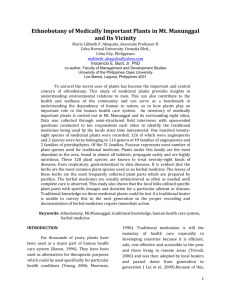RRR
advertisement

MARINE LIFE PROTECTION ACT INITIATIVE: SOUTH COAST STUDY REGION ADDENDUM NARRATIVE TO DRAFT EXTERNAL PROPOSAL C, ROUND 2 REVISED RESUBMISSION The revised Round 2 Draft External Proposal C generated by the Santa Barbara Channelkeeper and the Santa Monica Baykeeper maintains an intention to delineate a network of Marine Protected Areas (MPAs) throughout the South Coast Study Region consistent with the goals of the Marine Life Protection Act (MLPA), in particular those that prioritize the conservation and restoration of our marine life, habitats and ecosystem function. As was the case with the starting point of Draft External Proposal C in Round 1, the design of the revised Marine Protected Area (MPA) network in Proposal C for Round 2 continues to be founded on natural science and reserve design, with revision being attributed to updated guidance and Round 1 evaluative feedback from the MLPA Initiative, additional data and refined information on the region’s marine resources, and input from other groups with regional interests, in particular regarding concern for short term socio-economic impacts to consumptive interests. The underlying intent and approach of revised Proposal C remain the same as the original and can be reviewed in the Round 1 proposal narrative (to follow this addendum). Since the submission of Round 1 proposals, there has been significant improvement made in the refinement of habitat identification methods and in the ability for the public to access the same data used by the MLPA Initiative to identify attributes of the marine resources in the South Coast Region, specifically in identifying the kelp, hard and soft bottom habitats and the place-based value to commercial and recreational fisheries. In addition, the proponents of Proposal C have solicited for local place-based interest and knowledge from individuals and groups, including initiating dialogs with fishermen, to better identify marine resources and value in the South Coast. This fostered new and refined knowledge is reflected in Round 2 revised Proposal C with the design of the MPA array and individual MPAs improved upon in an effort to find complimentary solutions in better adhering to the goals of the MLPA, meeting the Initiative guidelines and considering impacts to consumptive interests. And when these criteria were incongruent, we made every effort to balance these recommendations with priority given to meeting the goals of the MLPA. As an example, Proposal C does exceedingly well at meeting the SAT habitat spacing guidelines (with the allowed exception of identified rare habitats) and it would have met all the spacing guidelines but a concession was made in two locations for kelp habitat and one for soft habitat in recognition of two sites identified as critically important to consumptive interests (Carpinteria and Dana Point). Many other design considerations and recognized balances are explained in detail in the MPA descriptions. Similarly, the proponents of Proposal C are awaiting guidance on military uses from the Blue Ribbon Task Force and will consider concessions based on that guidance at the Channel Islands and certain mainland sites. Until then, Proposal C will maintain its original proposed MPAs at the islands. And while it is sometimes necessary to make concessions in light of contrasting criteria, Round 2 revised Proposal C is intended to maintain the principled approach that an array of large, fully protected marine reserves that prioritizes high quality and unique habitats is necessary for meeting the goals of the MLPA and restoring and sustaining the ecological integrity of California’s marine life, resources and ecosystems and maximizing the associated long-term economic benefits for California. The recognized importance of Proposal C’s approach of prioritizing conservation in order to meet the goals of the MLPA is reflected in the multitude of entities that have voiced their support and endorsement for Draft External Proposal C since its inception- including local and national conservation organizations, recreational clubs, scientists, educational organizations and recreational businesses. Exprop C Round 2 narrative.doc In Round 2 revised Draft External Proposal C, the MPA array consists of 49 MPAs of which 41 are designated SMRs, one State Marine Parks (SMPs), six State Marine Conservation Areas (SMCAs) and one State Marine Recreational Management Area (SMRMA) (this includes the existing MPAs at the north Channel Islands). Ten of the 41 SMRs are estuaries, lagoons, salt marshes, or bays. In this proposal, 30.2% of the South Coast Study Region total area is designated as MPAs, with 27.2% as SMRs, 0.5% as SMPs, 2.4% as SMCAs, and 0.1% as SMRMAs. NARRATIVE FOR ROUND 1 DRAFT EXTERNAL PROPOSAL C External proposal C generated by the Santa Barbara Channelkeeper and the Santa Monica Baykeeper intends to delineate a network of Marine Protected Areas (MPAs) throughout the South Coast Study Region consistent with the goals of the Marine Life Protection Act (MLPA), in particular those that prioritize the conservation and restoration of our marine life, habitats, and ecosystem function. The design of this network is founded on the scientific principles of ecology, biological and physical oceanography, conservation biology, biogeography, and natural reserve design. As such, the location, size and spacing of the MPAs in this proposal are driven by the availability and type(s) of habitats and biological resources resident within these areas. The relative quality of the existing habitats and biological communities was applied to site selection and central to the spacing and sizing determinations. Priority was given to locations containing relatively robust key habitat and corresponding attributes such as stable biogenic structure, high relief substrates, and upwelling zones. The MPAs proposed in this network were selected for these characteristics and the highest priority was given to MPAs that encompass as many of these features while considering the other goals of the MLPA Initiative. Furthermore, we take seriously the guidance provided by a growing body of scientific evidence on the effectiveness of marine protected areas around the globe. Specifically, that the greatest biological benefits are realized from the highest level of protection afforded by no-take marine reserves and that larger MPAs contain the home ranges of a greater number of individuals of a population than smaller MPAs. In addition, strategically sited large MPAs have the additional benefit of including a higher variety of habitat types, better encompassing entire life stages and, across functional group, critical species interactions. As a result, the living resources of our coast are likely to respond far more rapidly to the protections provided by a network of large, highly protective MPAs, leading to a relatively quick much needed restoration of ecosystem structure and function. The MLPA Initiative Science Advisory Team (SAT) has directed alternative MPA network proposals to recognize that the biological communities of the South Coast are distinctly different and represent five delineated yet interconnected bioregions, within which sufficient habitat representation and repetition need to be considered in MPA network design. Accordingly, protections of resources at the bioregion scale are requisite of a successful network in the South Coast. Thus strong consideration was given to create a network that functioned within these bioregions, and throughout the South Coast study region. We reduced the spacing when necessary to accommodate the replication of habitat types within bioregions. Throughout the designation of our MPA network, while meeting the goals of the MLPA, we gave serious consideration to socioeconomic values and impacts as recommended by the Blue Ribbon Task Force (BRTF). Whenever possible we mitigated for short-term socioeconomic concerns. However, sound socioeconomic policy for any natural resource planner requires long-term sustainability, and ecological resilience of the resource(s) take precedent. This tenet is the principle rationale for the socioeconomic considerations manifest in this proposal. The measured opinion of the authors represented here is that the South Coast is in need of the Exprop C Round 2 narrative.doc protections provided by the MLPA; a network of MPAs designed to achieve the goals of the MLPA will support, not detract from, the diverse interests and industries of our coastal economy. Consistent with the goals of the MLPA, we looked to support and cultivate recreational, educational, study, efficient management, and enforcement opportunities in our proposed MPAs. Preference was given to areas with existing educational programs, ongoing research, and in-place mechanisms of enforceability. To promote recreational use of MPAs, public access, proximity to harbors, and areas compatible with and/or reliant on tourism (including land-based state or local parks and beaches) were given priority. While the MLPA Initiative’s scientific guidelines are not specific in relation to the level of protection and spacing of MPAs encompassing the waters of our offshore islands and tidally-influenced estuarine environments, we took seriously their uniqueness and the great importance these areas play in the overall protection of California’s marine resources and ecosystem function. The critical ecological role wetland environments play in marine ecosystem function is well understood. Greater than ninety percent of southern California’s coastal wetlands have been lost or compromised by development and other habitat modifications. This unavoidable truth demands that we make every effort to protect and restore the few estuaries that still exist today. To this end, we have designated many of the most ecologically important and intact estuaries in the South Coast Region with the highest level of protection as State Marine Reserves (SMRs). The ecological significance of the marine life and habitats that exist at our offshore islands and the fact that much of these communities are still relatively robust also warrants large MPAs with the highest level of protection in these areas. Furthermore, the recognition that islands group as distinctly different bioregions suggests that their unique community compositions are a result of being relatively isolated and self contained environments, emphasizing the need to comprehensively replicate habitat types within island waters. In addition, islands characteristically show significant differences in community composition on leeward versus windward sides of islands, driven by primarily geographical and oceanographic differences, warranting distinct MPA placement and replication to account for these differences. Finally, as directed by the MLPA, existing state marine resource management efforts should be considered when designing an effective MPA network and existing MPAs should be evaluated for their effectiveness in meeting the goals of the MLPA and subsequently modified, allowed to remain, or removed depending on the result. In most cases, existing MPAs were geographically located in areas where they were incorporated into MPA designations that encompassed more area and/or afforded a higher level of protection under the new MPA designation. For one MPA that did not fall under this scenario but whose regulatory protection level, size, spacing, and habitat representation met the goals of the MLPA and the guidelines of the SAT and BRTF, we kept the MPA as was originally designated. In all other cases, the existing MPAs were removed. In addition, other state marine resource management efforts, such as Areas of Special Biological Significance, were taken into consideration as means to enhance the effectiveness of an MPA or rationale for MPA placement. The end result of our deliberations and outreach is Proposal C, an MPA network design that we feel meets the explicit goals of the MLPA to protect, conserve, and restore California’s marine life, habitats, natural heritage, and ecosystem function. The paramount priority of our network is its ability to meet these goals; it promises long-term benefits to Californians and the restoration and sustainability of our marine resources. To meet this obligation, we have followed the guidelines of the SAT, the BRTF, the Department of Fish and Game and the MLPA Initiative staff in concert with a more comprehensive attention to the scientific principles of natural reserve design that identify the prioritizing criteria stated above. Exprop C Round 2 narrative.doc







